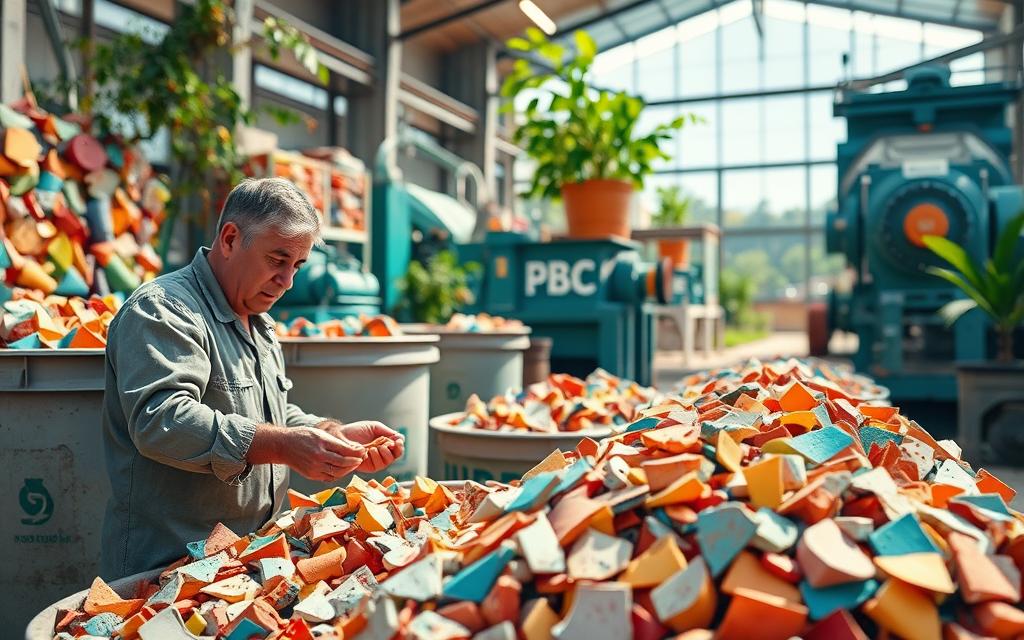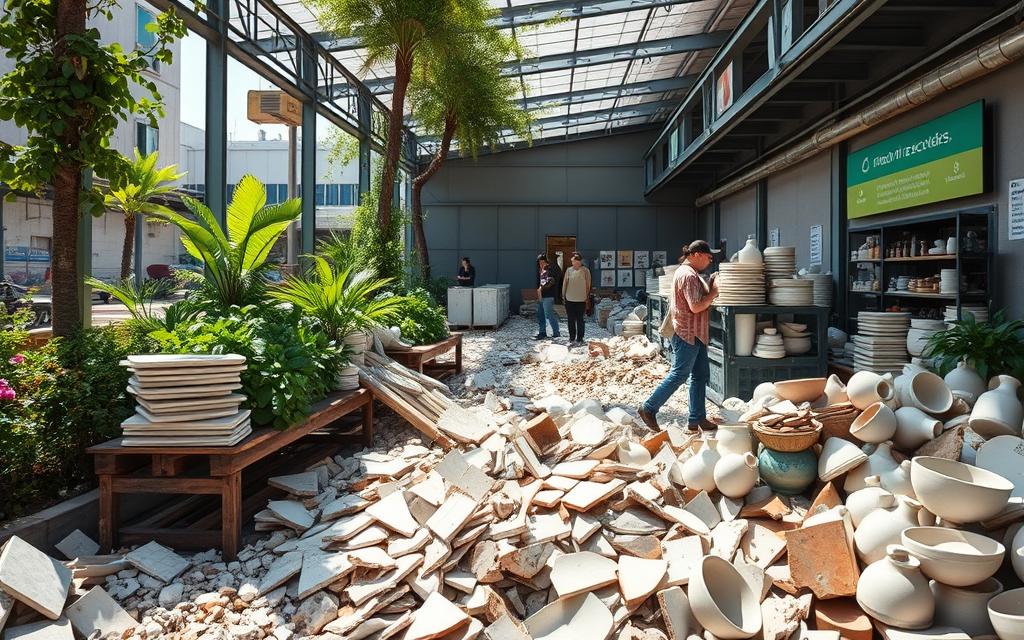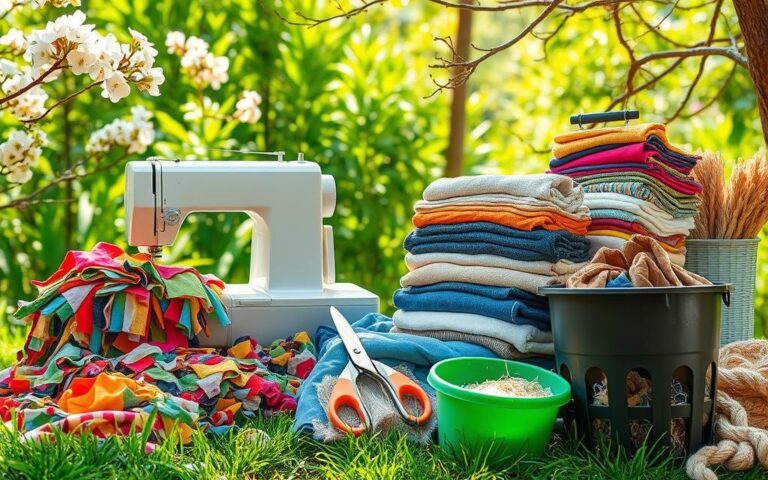Can You Recycle Ceramic? Eco-Friendly Disposal Options
As the world focuses more on sustainability, wondering if you can recycle ceramic is key. Many face difficulties in managing ceramic waste. This happens as traditional recycling doesn’t always accept ceramics. They are too durable but get left out, causing pollution. This article will look at eco-friendly ways to dispose of ceramics. We’ll cover everything from community recycling efforts to creative reuse ideas.
Understanding Ceramic: A Brief Overview
Ceramics have been crucial throughout human history, showing off our creativity. Learning about ceramics opens up our eyes to their many uses. These uses highlight why ceramics are so valuable. They’re made by mixing clay with other things, then heating them up till they harden. This technique has been perfected over thousands of years. It allows us to create items that we use every day.
What is Ceramic?
Ceramics include a huge variety of items, such as pottery and tiles, and even stuff used in technology. But defining ceramics isn’t just about knowing what they look like. These materials are known for being strong and able to handle heat and chemicals well. They have been important throughout history, not just for their usefulness but also for their beauty. From ancient tools to today’s buildings and tech, ceramics have evolved.
The Properties of Ceramic Materials
Knowing what makes ceramics special helps us see why they’re used for so many things. Here are some key features:
- Durability: Ceramics can stand up to a lot of wear and tear. This makes them perfect for both looking pretty and being useful.
- Heat Resistance: They can take a lot of heat without breaking down. This is why they’re good for pots and engines.
- Chemical Resistance: Ceramics don’t react much with other chemicals, making them last longer in all sorts of settings.
- Low Porosity: They don’t soak up water, which means they’re great for things like roof tiles and bathrooms.
This brief look at ceramics shows us the impact of human skill and creativity on these lasting items. Their mix of usefulness and beauty makes ceramics important both in the past and today.
Types of Ceramics
Looking into different types of ceramics, we find each has its own special traits and uses. It’s crucial to know these differences. They impact how we manage and dispose of ceramic items after they’re no longer needed.
Porcelain
Porcelain stands out for being both fine and tough. It’s often seen in quality dinnerware and luxury table settings. The making of porcelain involves heating it at very high temperatures. This results in a glossy, non-porous finish, perfect for both use and display.
Stoneware
Stoneware brings together durability with visual appeal. Common items like mugs and ovenware are made from it, thanks to its sturdy nature. Its glazed surface not only looks good but also keeps water out. This trait makes stoneware a go-to option for cooking and serving.
Earthenware
Earthenware is known for being porous, which lends itself well to decorative items and garden pots. It’s baked at lower temperatures, giving rise to a softer substance. Though it can be colourful and appealing, earthenware is not as strong as porcelain or stoneware.
Can You Recycle Ceramic? An In-Depth Look
Recycling ceramic is tricky due to its long-lasting and non-biodegradable nature. Most traditional recycling methods can’t effectively process it. Some local facilities may take ceramics, but they need special treatment as per the recycling rules. Hence, knowing how to recycle ceramics properly is essential for those who care about the environment.
In places like Cambridge, recycling focuses more on metal, glass, and paper. Ceramics are often left out. This is mainly because the usual curbside recycling program doesn’t cover ceramics. They could even cause problems by contaminating other recyclables. It’s important for buildings with many families to have the right bins. This helps everyone know how to get rid of ceramics the right way.
If you need to throw away broken tiles or ceramic goods, you have a few choices. Many local recycling centers don’t take ceramics because recycling them is complex. But calling around can reveal other options. And if you have a lot to dispose of, hiring a dumpster might make things easier.
| Material | Allowed in Curbside Recycling | Recycling Alternatives |
|---|---|---|
| Ceramics | No | Contact local recycling companies, hire junk removal services |
| Glass bottles | Yes | N/A |
| Plastic containers | Yes | N/A |
| Metal cans | Yes | N/A |
| Tiles | No | Consider dumpster rental, junk removal services |

Ceramic and Biodegradability
Ceramics are a big part of our lives but their effect on the environment is less known. They don’t break down easily, making their disposal a problem. They can stay in landfills for a very long time.
The Decomposition Timeline for Ceramics
Ceramics can take thousands of years to decompose. They resist breaking down because microbes can’t act on them. This leads to a buildup of waste in landfills.
This situation is troubling for managing waste. It also poses questions about its long-term environmental effects. The slow decay of ceramics affects natural spaces negatively.
Environmental Implications of Non-Biodegradable Ceramics
The effect of ceramics on the environment is significant. They fill landfills and stop natural recycling processes. Ceramics don’t help the soil. Instead, they just add to pollution.
With a focus on sustainability, we must consider these impacts. Finding other uses or recycling ceramics can help reduce their environmental harm.
| Material Type | Biodegradable | Decomposition Timeline | Environmental Impact |
|---|---|---|---|
| Ceramics | No | Thousands of years | High persistence in landfills |
| Organic Waste | Yes | Weeks to months | Enriches soil and reduces landfill use |
| Plastics | Some types | Hundreds of years | Contributes to pollution and landfill volume |
Composting Alternatives: How to Handle Ceramic Waste
Ceramic waste poses a unique challenge because it can’t decompose. We need smart solutions to deal with it. Options include finding new uses for ceramics or recycling them. Doing so can lessen the environmental impact of this waste.
Repurposing Ceramic Items
Give old or broken ceramics new purpose. Here are some ideas:
- Garden mosaics: Use broken pieces for beautiful mosaics in gardens.
- Plant pots: Turn old bowls or cups into planters for a unique touch.
- Decorative art: Create art or sculptures from shattered pottery.
Recycling Ceramics: What You Need to Know
Recycling can help reduce the amount of ceramics in landfills. Local centres often accept ceramics for various uses, like in construction. It’s important to find out what your local centre does. Remember, ceramics don’t belong in compost as they do not help the compost process.
For more details on managing waste, check out this resource. It explains why you can’t compost ceramics and suggests recycling instead. This approach helps save resources and manage waste better.
| Method | Description | Environmental Impact |
|---|---|---|
| Repurposing Ceramics | Creative reuse of broken ceramics in gardens, home decor, and art projects. | Reduces waste and encourages sustainable practices. |
| Recycling Ceramics | Crushing ceramics for use in construction and other applications accepted by recycling centres. | Conserves resources and minimises landfill contributions. |
| Composting | Not suitable for ceramics due to non-biodegradability. | No positive environmental impact; may hinder composting processes. |
Environmental Impact of Ceramics
The impact of ceramics on the environment is significant and needs our attention due to their lasting presence in landfills. These materials do not break down, leading to tough challenges for waste management. The vast amount of ceramic waste leads to overflowing landfills, highlighting the need for eco-friendly practices.
Improving the sustainability of ceramics is becoming more necessary. Recycling water in ceramics can greatly reduce waste. By reusing water to clean tools and separating clay, we conserve resources. Clay recycling lets artists use excess materials again, reducing waste and showing the value of using resources wisely.
Energy use in ceramic production is another important issue. Kiln operation uses a lot of power. Artists can save energy by filling kilns efficiently and using renewable energy. These steps lower the environmental effects of ceramics and move us towards a greener future.
- Using safe ingredients in glazes protects both workers and users.
- Choosing local materials cuts carbon emissions compared to using imports.
- Recycling avoids landfill use and cuts the demand for new materials.
The ceramics industry can use a lot of water, up to 5% of available supplies. So, it’s critical to find ways to reuse water in production. Recycling also tackles overproduction and encourages the creation of eco-friendly products.
To make ceramics more sustainable, we need both small personal actions and big policy changes. As the industry grows, our commitment to research and new technologies will help us achieve goals like zero emissions, no waste, and fewer non-recyclable products.
| Strategy | Description | Benefits |
|---|---|---|
| Water Recycling | Reusing water for cleaning tools and separating clay from wastewater. | Minimises waste and conserves valuable resources. |
| Clay Reclamation | Breaking down and reusing dry clay scraps. | Reduces waste and promotes resource efficiency. |
| Energy Optimisation | Improving kiln efficiency and utilising green energy solutions. | Lowers power consumption and carbon emissions. |
| Local Sourcing | Using locally mined materials for production. | Decreases CO2 footprint compared to imports. |
| Recycling Implementation | Incorporating recycling into the manufacturing process. | Reduces landfill waste and promotes eco-friendly production. |
Conclusion
This article talked about the tough issues with recycling ceramics and how it affects our environment. Ceramics add a lot to landfills, but we can change that by picking sustainable ways to get rid of them. Knowing which ceramics can be recycled, especially avoiding those with dangerous stuff like lead, is key for eco-friendly choices.
By joining ceramic recycling efforts and finding new uses for things we don’t need, we can cut down on waste. This also stops bad chemicals from harming our world. It’s vital to understand the big role companies and charities have. They help raise awareness and find answers to deal with ceramic waste.
Making smart decisions on how we throw away ceramic items can make our lives more earth-friendly. Stressing recycling and reusing, plus supporting local projects, saves our natural treasures. It also brings us together to work for a better tomorrow. Small actions now can make a big difference for our earth’s future.
FAQ
Can I recycle ceramics at home?
Recycling ceramics at home is usually not possible. They don’t break down easily. It’s better to ask local recyclers if they can handle them.
What types of ceramics can be recycled?
Some places might recycle certain ceramics like porcelain. Always check with your local recycling centre to see what they’ll take.
How long do ceramics take to decompose in landfills?
Ceramics take a very long time to break down, often thousands of years. They don’t rot because microbes can’t break them down. This makes waste harder to manage.
What are some creative ways to repurpose ceramics?
You can get creative with old ceramics. Use broken pieces for garden projects. Make home decor or artistic mosaics from them.
What are the environmental implications of ceramics?
Ceramics fill up landfills since they don’t decompose. This creates big challenges for waste management. We need better ways to get rid of them.
Are there any eco-friendly disposal options for ceramics?
There are greener ways to dispose of ceramics. Try repurposing them or see if local recycling points accept crushed ceramics for building use.















